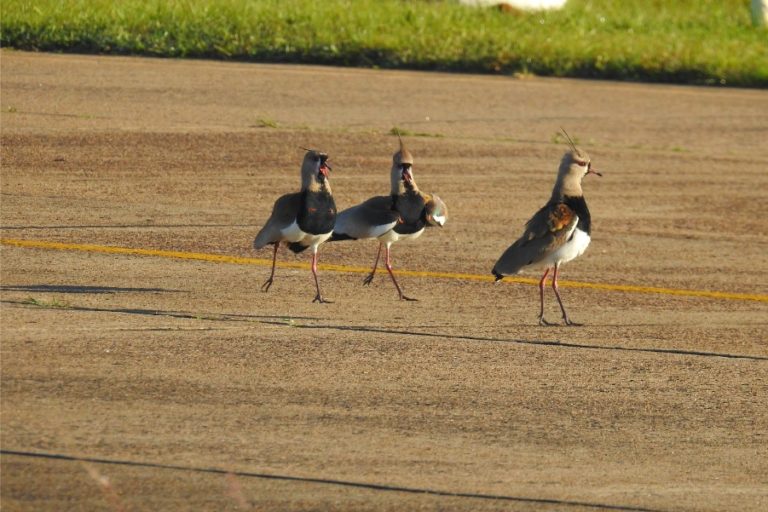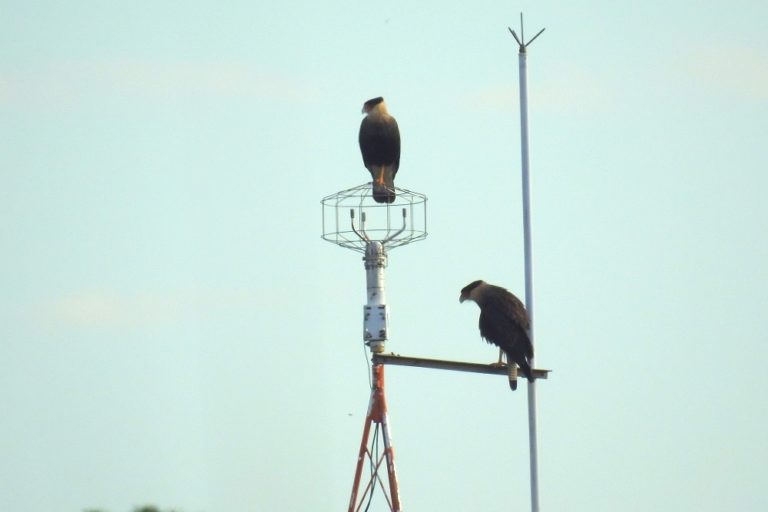- More than 2,000 wildlife strikes with aircraft are reported in Brazil every year, but the numbers are underreported and don’t specify the species affected.
- The vast majority of the animals hit are birds: southern lapwings (Vanellus chilensis), crested caracaras (Caracara plancus) and vultures (family Cathartidae).
- Direct and indirect damages generated by wildlife strikes amounted to more than $76 million between 2011 and 2020.
- A study found that birds living near airports altered their song patterns and had altered stress hormone levels.
Wildlife strikes, or collisions between aircraft and animals, are flight safety risks. In Brazil alone, more than 2,000 cases are reported annually by CENIPA, the Aeronautical Accidents Investigation and Prevention Center. However, these and other negative impacts of airplane traffic on wildlife are rarely studied from the perspective of conservation and the well-being of animals by scientists and airline industry decision-makers in Brazil.
“I have found that the research is more focused on operational safety than on the way wildlife is impacted, sometimes only granting a mention to the topic,” says Mariane Biz, a biologist and director of the World Birdstrike Association (WBA). Biz is also a partner at ProHabitat, a company that manages issues involving wildlife at airports, and director of REET Brasil, the Brazilian Transport Ecology Specialists Network. She tells Mongabay that, in Brazil, the philosophy still prevails that the species most frequently killed in collisions with airplanes are not of “relevant ecological interest” because they’re considered to be “common.”
But Biz says this may not actually be the case. She says animal deaths by aircraft are underreported and that 47% of the reports in CENIPA’s Avian Risk Management System, known as SIGRA, don’t specify the species of the animals involved. “Could it be that in today’s global scenario, as we teeter on the edge of planetary limits, we can ignore so-called ‘common species’?” she says.
CENIPA, which falls under the purview of the Brazilian Air Force, populates its SIGRA database with technical information on wildlife sightings, near strikes, and strikes between aircraft and animals. Anyone can submit data, which is analyzed by specialists for flight safety management.

The most recent Fauna Risk Yearbook was published in 2021 with SIGRA data, showing that 2,145 wildlife strikes were reported in Brazil in 2020. This was less than in the previous year (2,851), because of pandemic-related transport restrictions. Biz says that because animal death rates are extremely high in these cases, each strike can be counted as a death, and the total number of reported strikes should be considered an undercount, because not all collisions are seen or registered in the system. Nevertheless, the SIGRA data history shows a significant increase in strikes. In 1996, the year that the first counts were published in the yearbook, 127 wildlife strikes were reported for a national fleet of 9,768 aircraft. The highest number reported in a single year was in 2019, with 2,851 cases for a national fleet of 16,554 aircraft. According to ANAC, the National Civil Aviation Agency, aside from the growing numbers of aircraft, there are more reports of animals being hit by planes because of increased airport traffic, technology that has made planes faster and more silent, and the fact that a culture of reporting such incidents is growing
Financial concern
Biz says the number of aviation-related deaths, while much lower than those animals killed by cars on roadways — an estimated 475 million wild animals across Brazil in 2013, according to Lavras Federal University’s Center for Road Ecology (CBEE/UFLA) — is still significant. “Unfortunately, the industry is mostly concerned about these cases because of flight safety and the resulting financial losses,” she says.
And the losses aren’t small. The Fauna Risk Yearbook says the direct costs generated by wildlife strikes, which include parts and repairs of planes and indirect costs like flight cancellations, delays and passenger costs, amounted to more than $76 million over the 2011-2020 period.
ANAC tells Mongabay that Brazilian civil aviation regulations specifically address the question of wildlife strikes, under the section on “fauna risk management.” It lists a series of measures for reducing the risk of accidents involving wild animals, primarily with an eye on air safety, and clearly stating that wildlife presence at aircraft facilities is a risk-generating factor.
The most affected species
According to SIGRA data, more than 90% of the species identified in the accidents between 2011 and 2020 were birds. The most common were southern lapwings (Vanellus chilensis), accounting for 32.5% of the cases; crested caracaras (Caracara plancus), at 13%; and vultures (family Cathartidae), at 6.4%. None of these species are considered at risk of extinction in Brazil. Biz says academic studies on this topic are just beginning to be carried out, and that no Brazilian university has a center exclusively dedicated to looking at the problem of wildlife strikes. “Whenever I can, I tell people that researchers are lacking on this topic. I think that, since it doesn’t carry the same biodiversity conservation appeal as roadkill, and because airport regulations are so difficult to challenge, many professionals aren’t motivated to work in this area,” she says.
Noise pollution
One of the main negative impacts that aviation has on wildlife is noise pollution. The high noise levels emitted by planes affect birds living near airports.
Biologist Renata Alquezar completed her Ph.D. at the University of Brasília in 2018, focusing on the effects of noise pollution on the songs and physiology of birds living near the international airports of Presidente Juscelino Kubitschek in Brasília, Viracopos in Campinas, São Paulo state, and Deputado Luís Eduardo Magalhães in Salvador, Bahia state. “They are very busy airports whose runways are surrounded by natural habitats,” Alquezar says.
Her research included comparisons between birds living at the airports (disturbed environments) and those living in preserved ecosystems (undisturbed environments) some 8-17 kilometers (5-11 miles) away from the air traffic. Alquezar carried out her fieldwork during different periods in 2014, 2015 and 2016, and described local landscape characteristics (vegetation, noise and light levels) and bird records. In total, she recorded 154 bird species through mist net captures and call recordings at the airports and in the undisturbed areas; 57-61% of these species were found in both disturbed and preserved areas.
As expected, diversity and number of animals were greater in the locations far from air traffic. “Our data showed loss of diversity in the regions affected by airports, even though we were not able to discriminate between the relative effects of fragmentation, degradation and noise for these patterns,” Alquezar wrote in her thesis.

Another change Alquezar identified involved the songs of five bird species. She analyzed the calls of 15 species and discovered that two of them — the shrike-like tanager (Neothraupis fasciata) and the lesser elaenia (Elaenia chiriquensis) — began singing earlier at daybreak nearby airports. She also found that three other species began singing later: the southern beardless tyrannulet (Camptostoma obsoletum), the southern house wren (Troglodytes musculus) and the rufous-collared sparrow (Zonotrichia capensis). “In addition, the birds that began singing earlier sang for longer periods in the morning,” Alquezar says, citing this as another adaptation by the species to noisy airport environments.
Birdsongs serve different purposes, such as to attract mates, defend territory, and as communication between parents and offspring. The so-called dawn chorus normally begins 30-60 minutes before sunrise, and the calls are more complex and intense than those during the rest of the day.
Alquezar also analyzed corticosterone levels in the wings of 821 birds from 19 species living in the vicinity of the three airports. The concentration of this hormone is a gauge for bird stress levels. Altered levels were found in four of the species studied: the rufous-browed peppershrike (Cyclarhis gujanensis) and the rufous-bellied thrush (Turdus rufiventris) had elevated levels of the hormone, while the southern house wren and red-crested finch (Coryphospingus cucullatus) had lower levels.
Increased corticosterone levels can leave birds susceptible to parasites and shorter life spans in nature. Meanwhile, lower levels can lead to reproductive problems. In both cases, the animals are exposed to chronic stress.
Airports and conservation units
“Brazil has no specific legislation on noise, wildlife and airports [regarding conservation]. These values should be established, including acceptable noise levels in conservation units, for example,” Alquezar says.
In a 2019 study, she looks at the airport in Brasília, which lies inside the Gama e Cabeça-de-Veado Environmental Protection Area and is surrounded by three areas of relevant ecological interest (ARIEs in Portuguese): Capetinga-Taquara, Granja do Ipê, and Riacho Fundo. The airport is also located near the Botanical Gardens Ecological Station, the Brazilian Institute of Geography and Statistics Biological Reserve, the Brasília Botanical Gardens, and the Brasília Zoological Gardens.
Medium and large-sized animals live inside these areas, including pumas (Puma concolor), ocelots (Leopardus pardalis), South American tapirs (Tapirus terrestris), maned wolves (Chrysocyon brachyurus), crab-eating foxes (Cerdocyon thous), giant armadillos (Priodontes maximus), giant anteaters (Myrmecophaga tridactyla), black howler monkeys (Alouatta caraya) and gray brocket deer (Mazama gouazoubira). Alquezar and co-author Regina Macedo analyzed the routes and altitudes of flights passing over the Botanical Gardens Ecological Station and found that the planes bank at altitudes of approximately 500 meters (1,640 feet), generating high noise levels. The impact of the noise pollution on these animals is unknown. Alquezar says noise limits and operational changes to routes and takeoff and landing altitudes need to be established for each type of conservation unit, together with updated land-use plans for areas surrounding the airports.

Banner image by Maarten Visser via Flickr (CC BY-SA 2.0).
This story was reported by Mongabay’s Brazil team and first published here on our Brazil site on Nov. 14, 2022.
Citations:
Alquezar, R. D. (2018). Efeitos da poluição sonora nas características do canto e na fisiologia das aves (Doctoral dissertation, University of Brasília, Brasília, Brazil). Retrieved from https://repositorio.unb.br/handle/10482/32831
Alquezar, R. D., & Macedo, R. H. (2019). Airport noise and wildlife conservation: What are we missing? Perspectives in Ecology and Conservation, 17(4), 163-171. doi:10.1016/j.pecon.2019.08.003
